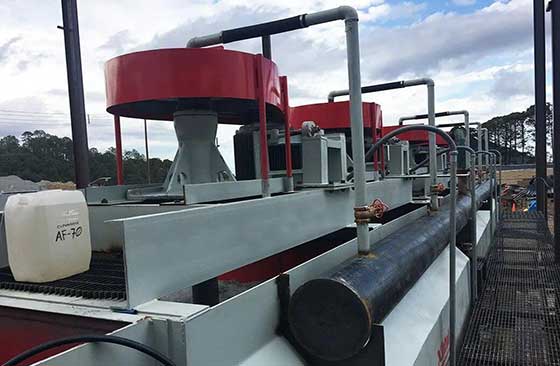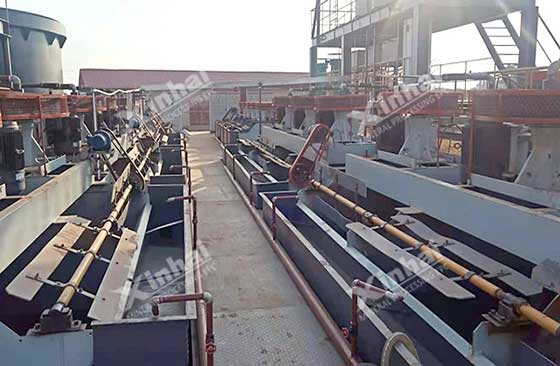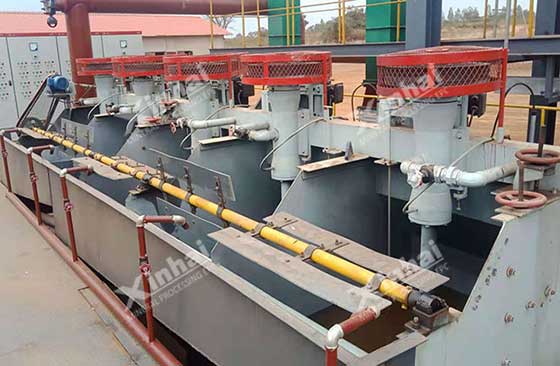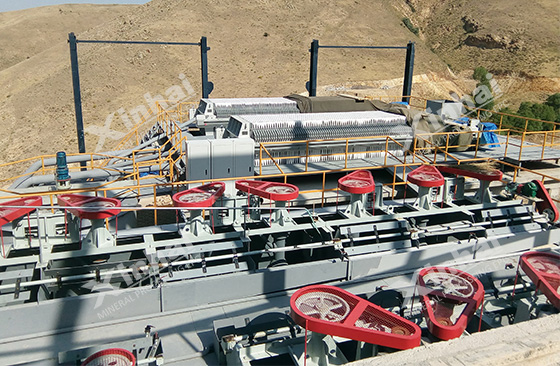
80-90% of the world's phosphate rock is used in the production of phosphate fertilizers, feed additives, etc. It is not only used in agriculture, but also widely used in chemical industry, light industry, national defense and other industrial fields, so the status of phosphate rock is very important. Due to the continuous development and utilization of phosphate rock resources in recent years, high-grade lithium ore resources have been increasingly reduced, and the utilization of low-grade phosphate rock resources has attracted more and more attention. Choosing a reasonable mineral processing method can greatly improve the phosphate processing efficiency. The following will introduce you to phosphate ore beneficiation process: the flotation, gravity separation, roasting and digestion process, and organic acid leaching method.
The phosphate rock flotation process can be divided into forward flotation, reverse flotation, forward-reverse flotation, and reverse-forward flotation according to the flotation sequence.

1. positive flotation
Positive flotation is direct flotation, usually carried out in alkaline slurry, and concentrates phosphorus minerals in the foam by suppressing gangue minerals.
Positive flotation can be used to treat silicocalcine collophosphate. Because of its finer particle size and large difference in floatability with gangue minerals, gangue minerals and collophosphate can be effectively separated from gangue minerals by using a reasonable chemical system. .
Positive flotation can also be used to process magmatic apatite, because the phosphorus minerals in the ore have the characteristics of complete crystallization and coarseness. Fatty acid-based collectors are used and the difference in surface properties with gangue minerals is used to sort the fine ones. Sedimentary calcareous phosphate rock with particles embedded in it. As for the phosphorus minerals, inhibitors are used to increase the difference in floatability with the gangue minerals, and then fatty acid collectors are used to recover them.
The positive flotation process is simple and widely used in mineral processing plants. Since the flotability differences between magnesium oxide, carbonate and collophosphate rock are small, positive flotation is suitable for those materials with relatively low magnesium oxide and carbonate contents.

2. Reverse flotation
Reverse flotation first suppresses phosphate rock and leaves carbonate substances at the bottom of the tank. This process is suitable for processing collophosphate rock rich in magnesian gangue minerals, especially sedimentary magnesian phosphate rock. When treating high-grade sedimentary calcareous phosphate rock, the reverse flotation process can effectively separate the phosphorus minerals and calcium-containing carbonate gangue minerals in the ore. The floatability of phosphorus minerals is similar to that of calcium-containing carbonate minerals. Sulfuric acid or phosphoric acid is used to inhibit the floating of phosphorus minerals. Fatty acid-based agents are used to float calcium-containing carbonate minerals, and the phosphorus minerals remain in the flotation tank. . A typical example of reverse flotation application is the separation of colloidal phosphate rock from dolomite. Under the condition that the slurry is weakly acidic, fatty acid is used as a collector to separate the dolomite, and the colloidal phosphate rock can be purified.
3. Positive and negative combined flotation
The properties of colloidal phosphate ore in nature are complex and changeable. Using forward flotation and reverse flotation alone will cause some problems. For example, it is difficult to obtain products through forward flotation, while the mineral particles obtained by reverse flotation are finer and inconvenient to transport. and subsequent processing. Therefore, when necessary, it is necessary to use a forward and reverse combined flotation process to treat colloidal phosphate rock, such as forward and reverse, reverse and forward, double and reverse, double and forward processes, etc.

Forward and reverse flotation and forward and reverse flotation are suitable for the processing of calcium carbonate-siliceous phosphate rock, because the siliceous material in this type of ore is closely symbiotic with phosphorus minerals, and phosphoric acid is used as an inhibitor of phosphorus minerals. , and then use fatty acids to remove carbonate minerals first. Water glass is used as an inhibitor to prevent silica from escaping, and fatty acids are used to recover phosphorus minerals.
Flotation is sometimes combined with magnetic separation to process phosphate rock containing magnetic minerals such as iron and titanium, but it is rarely used in practical applications.
Phosphate ore flotation process equipment: Jaw crusher, ball mill, flotation cell, conditioning tank, thickener, filter press
The key to sorting heavy media lies in the difference in specific gravity of different minerals. Different density differences can sort minerals. This is a physical mineral separation method. Low-grade phosphate ore can eliminate gangue minerals in advance through this method to improve the efficiency of subsequent separation processes. The gravity separation process has the characteristics of fast separation speed and no pollution, and is widely used in mineral processing plants. The gravity separation method is mainly used for the separation of calcareous and siliceous phosphate ores. Since the density of gangue minerals such as calcite, dolomite, and quartz in the ore is close to that of apatite minerals, heavy media separation process is commonly used in actual production.
Phosphate rock heavy medium separation equipment: Crusher and screen, dense media cyclone, magnetic separator, media circulation system
The roasting and digestion method belongs to thermochemical mineral processing, that is, roasting the phosphate rock to decompose the carbonate impurities contained in it, and then remove it after scrubbing. The roasting and digestion method is mainly used for phosphate rocks with high carbonate content and low silicon content, but this method strictly requires the SiO2 content in the phosphate rock to be less than 5%.
quipment required for Phosphate ore Roasting and Digestion process: Rotary kiln, dryer, cooler, crusher & screen, flue gas purification system
For carbonate minerals with extremely fine particle sizes, strong acid or weak acid can be used to leach the colloidal phosphate minerals. However, acid treatment also has shortcomings. Strong acid will dissolve some useful minerals and reduce the recovery rate of phosphate concentrate, while weak acid will Greatly increases acid consumption and increases production costs.
Equipment required for Phosphate ore Organic Acid Leaching: Leaching tank, filter press, thickener, ion exchange column, wastewater treatment unit

The above is a brief introduction to phosphate ore beneficiation technology. Different technologies are applied to different types of ores. Reasonable beneficiation technology will improve the beneficiation efficiency and the recovery rate and quality of concentrate ore. Xinhai Mining can provide you with full industry chain services such as phosphate mineral processing technology and equipment. Welcome to consult.
To find out more about our products and solutions, please fill out the form below and one of our experts will get back to you shortly.